Effect of Nano CaCo3 as A filler and Linseed oil as an Extender on the Cure and Mechanical Properties of Natural Rubber Vulcanizates
Sheela S. Fernandez1 and Sam Kunchandy2
1Department of Chemistry, S. N. College, Chengannur, Alappuzha- 689508, India. 2Department of Chemistry, San Jacinto College, Central Campus, Pasadena, Texas TX 77505, US.
Natural Rubber (NR), filled with 2 to 8 phr of nano CaCO3 and 2 phr of linseed oil as an extender were compounded using a two-roll mill and moulded on a compression moulding machine. Effects of filler dosage on the cure and mechanical properties of the NR vulcanizates were examined. Because of the reduction in the size of the nano CaCO3, and the presence of linseed oil as an extender, that helped in the homogenous dispersion of the nano CaCO3, better cure and mechanical properties was observed. The composite with 6 phr of nano CaCO3 and 2 phr of linseed oil showed the optimum properties.
KEYWORDS:Vulcanizates; Natural rubber; Nano CaCO3; Linseed oil; Mechanical properties
Download this article as:| Copy the following to cite this article: Fernandez S. S, Kunchandy S. Effect of Nano Caco3 as A filler and Linseed oil as an Extender on the Cure and Mechanical Properties of Natural Rubber Vulcanizates. Orient J Chem 2013;29(1). |
| Copy the following to cite this URL: Fernandez S. S, Kunchandy S. Effect of Nano Caco3 as A filler and Linseed oil as an Extender on the Cure and Mechanical Properties of Natural Rubber Vulcanizates. Orient J Chem 2013;29(1). Available from: http://www.orientjchem.org/?p=25149 |
Introduction
Polymer composites have mechanical and heat resistance properties superior to pristine polymers, but the improvements are achieved at the expense of increased component weight, due to the higher loading of the filler required. Polymer nano composites play an important role in this regard. With recent developments in nanotechnology, there has been a growing interest in the field of nano composites, because of their special property enhancements. The reduced size, hence, increased specific surface area, distinguishes nano composites from conventional composites where filler particles are micron-size. A great deal of attention has been paid to nano-CaCO3, since it is the cheapest commercially available nano filler, and has the additional advantages of a low aspect ratio and a large surface area, which is able to impart significant improvements of specific polymer properties, such as stiffness and tensile strength, permeability, flame and scratch resistance as well as thermal stability.1 Several research groups have prepared natural rubber (NR) nano composites and found that the uniform dispersion of nanoparticles significantly enhanced thermal resistance and mechanical properties.2,3 Several researchers have prepared CaCO3 nano particles and studied the mechanical properties of the reinforced rubber-CaCO3 composites.4-8 To further improve the flexibility, processability and to get better filler dispersion, vegetable oil, such as linseed oil has been used as plasticizers in the natural rubber (NR) formulations. It has been observed that the vegetable oil-containing rubber compounds shows lower cure time, higher tensile strength, tear strength and elongation compared to the standard compound containing no vegetable oil.9,10 Linseed oil have been used as a multipurpose additive in Acrylonitrile butadiene rubber to improve its mechanical properties, processability and to reduce cure time.11
In the past, where reinforcement of the polymer was not the factor, inorganic fillers like CaCO3 were used to reduce the cost of the host polymer. But some recent studies showed that small amount of nano CaCO3 with linseed oil as an extender, that helps in the uniform dispersion, can improve the mechanical, thermal and swelling properties of styrene butadiene rubber.12 To the best of the authors knowledge, the effect of nano CaCO3 and linseed oil as filler on NR has not been reported until now. Hence in the present investigation an attempt has been made to investigate the effect of nano CaCO3 as filler and linseed oil as an extender on the cure and mechanical properties of NR composites.
Experimental
Materials
Natural rubber (RSS5) was procured locally. Common chemicals such as stearic acid, zinc oxide, accelerator F (mercaptobenzothiazyl disulphide and diphenyl guanidine), sulfur, 2,2,4-trimethyl-1,2-dihydroquinoline (TDQ) were of commercial grade. Calcium chloride dihydrate, potassium carbonate and polyethylene glycol (PEG, molecular weight 6000) were procured from Merck Specialities Pvt. Ltd., India. The linseed oil was supplied by Laboratory Equipments, Kerala, India. Nano CaCO3 was synthesized by in situ precipitation method as reported elsewhere12.
Compound preparation
The vulcanizates of NR were prepared by roll milling where the mixing of polymer and other ingredients was accomplished by squeezing the stock between two rolls (diameter: 150 mm) at 24 rpm. The formulation of the mix is given in Table 1. The CaCO3, linseed oil, and natural rubber used in this study have been coded as C, L, and N respectively. The loadings (phr) have been indicated by the numbers next to the component code.
Cure characteristic
The processing time for each mix was maintained at 20-30 min depending on filler loading. Rheometric properties such as cure time, t90 (time required for a given compound to achieve 90% of the final delta torque value at a given temperature), maximum and minimum torques (MH and ML), and scorch time (ts2, the time taken for two unit rise in torque above minimum torque, i.e., about 10% vulcanization) of the vulcanizates were studied by using a Mosanto moving die rheometer, (MDR 2000). The vulcanization of the rubber mixes was performed on a hydraulic press (platen size 8’ × 8’) under 30 tonne pressure at 150 °C according to their respective t90 values.
Mechanical properties
Tensile strength of the vulcanizates was measured by using Instron 4411 Universal Testing Machine (Instron Ltd, Buckinghamshire, UK) at a cross head speed of 500 mm min–1. The tensile experiments were conducted according to the ASTM D 412-87 test procedures using dumb-bell shaped test pieces. The tear strengths were estimated following ASTM D 624-81 using unnicked 90° angle test pieces.
Hardness
The hardness test of a rubber is the relative resistance of the surface to indentation by an indenter of specified dimension under a specified load. The hardness (Shore A) of the samples was measured using a Durometer (Modex India Pvt. Ltd., Mumbai, India) according to ASTM 2240-86.
Swelling behaviour
Equilibrium swelling of test pieces was carried out in toluene. The initial weight of the samples was taken and then introduced into toluene. These were removed periodically from the bottles, the adhering solvent was cleaned from the surface and then the sample was weighed immediately and then placed into the toluene again. The weight swelling ratio, Qt was determined from the weight of the sample in the unswollen and swollen states. Qt was thus calculated using the equation.
![]()
Where, Qt is the swelling ratio, Mt is the weight of the sample in the swollen state and Mo the initial weight of the samples. All tests were performed at room temperature (25°C), and the reported results were averaged from a minimum of three specimens.
Results and Discussion
Nanoparticle characterization
Figure 1 shows an XRD pattern for CaCO3 synthesized in PEG. Nano size CaCO3 was confirmed by the XRD pattern with Scherrer’s formula:
![]()
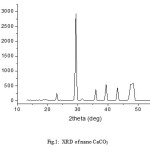 |
Figure 1: XRD of nano CaCO3. Click here to View figure |
Where d is the particle size, k is the order of reflection, λ is 1.542 and θ is the diffraction angle. The particle size was 20 ± 5nm.
Cure characteristics
The cure characteristics of NR vulcanizates with different loadings of nano CaCO3 with and without linseed oil are given in Table 2. The vulcanizates with nano CaCO3-linseed oilshowed fast curing time, compared to the nano-CaCO3 without linseed oil. The most probable factors to account for the observed cure enhancement is the plasticizing effect of the linseed oil, which helped in the homogenous dispersion of nano filler in the polymer matrix. The higher activity of unsaturated fatty acids of linseed oil further contributed to the lowering of the cure time. Scorch time indicates the period for which a compound can be stored safely before vulcanization. It also shows whether the compound is processable at higher temperatures. The difference in scorch times of the filled compounds is only marginal and the value indicate that there is adequate scorch safety for the compounds so that these can be stored or processed without any difficulty. MH-ML value indicates change in modulus due to extent of cross-linking and reinforcement by fillers. At equal volume loadings, compounds containing nano CaCO3 with linseed oil showed higher MH-ML values compared to nano filler without linseed oil. This indicated higher level of reinforcement by nano CaCO3 with linseed oil as an extender.
Swelling behaviour
The swelling ratio of different filler composites are shown in Figure 2. As can be seen, regardless of the filler type, the swelling ratio declines with increasing filler loading. These results indicate that the cross link density of the rubber vulcanizates increases consistently with increasing filler loading. It could also be observed that, at a given loading, nano CaCO3 with an extender gave the lowest swelling ratio followed by nano CaCO3 without an extender. The results imply that the specific surface area and the uniform dispersion of the nano filler due to the extender are the major factors affecting the swelling ratio of the vulcanizates.
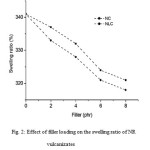 |
Figure 2: Effect of filler loading on the swelling ratio of NR vulcanizates. Click here to View figure |
Tensile strength
The relationship between the different loading of the filler and the tensile strength (TS) of NR/filler composites is shown in the Figure 3. The TS of NR/nano CaCO3-linseed oil composites was higher than that of the composites without an extender. The TS were recorded to be 21.6 and 20.2 MPa for the vulcanizate filled with nano CaCO3-linseed oil and nano CaCO3 respectively. In comparison with pure NR, nano CaCO3 with an extender showed 33% increase in the TS while nano CaCO3 without linseed oil exhibited 25% increment. Above 6 phr loading, the results for the nano fillers were not appreciable because the nano particles agglomerated at higher loadings due to filler- filler interaction.
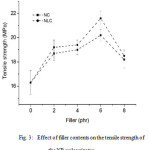 |
Figure 3: Effect of filler contents on the tensile strength of the NR vulcanizates. Click here to View figure |
Tear strength
The relationship between different loadings of filler and the tear strength of NR/filler composites are shown in the Figure 4. As can be seen the tear strength does not significantly change on increasing the filler loadings. However the tear strength of the composites filled with nano CaCO3 and extender, does increase up to 6 phr (36.5N/mm), but further increase in the loading of nano filler results in the decrease of tear strength. This initial increase in the tear strength was mainly attributed to the reduction of stress concentration at the crack tips in the presence of nano CaCO3, particularly those with the linseed oil, which helped in the uniform dispersion of nano particles in the polymer matrix. However, at higher loadings, beyond 6 phr of nano filler, agglomeration of particles may act as strong stress concentrators and thereby promote catastrophic failure, thereby reducing the tear strength
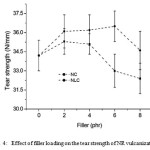 |
Figure 4: Effect of filler loading on the tear strength of NR vulcanizates. Click here to View figure |
Elongation at break
The relationship between elongation at break of NR composites and different loadings of filler is shown in the Figure 5. The NR/nano CaCO3 with and without linseed oil exhibited a higher elongation at break than the NR gum (565%) and increased with an increase in the filler content up to 6 phr, beyond which, it decreased. Further increase in filler loading causes the molecular mobility to decrease due to extensive formation of physical bond between the filler particles and the polymer chain that stiffen the matrix resulting in the lowering of elongation at break. The composites with 6 phr loading of nano filler showed a maximum elongation at break of 616%, but with the incorporation of linseed oil, the elongation at break decreased to 602%.
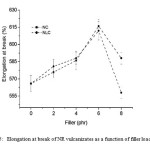 |
Figure 5: Elongation at break of NR vulcanizates as a function of filler loading. Click here to View figure |
The relationship between the modulus at 100% and the different loadings of the fillers in NR composites are presented in the figure 6. The nano filler composites generally show an increase in modulus values due to the better interaction between the filler and the matrix as the nano fillers have high surface area compared to conventional fillers, therefore there is a better chance for good interaction with the polymer chain. A better dispersion of the particles can be achieved by using an extender like linseed oil. The graph clearly shows that nano CaCO3 with linseed oil as an extender exhibits higher modulus (1.01MPa) than the nano filler without linseed oil. (0.99 MPa) at 6 phr loading.
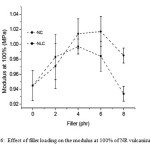 |
Figure 6: Effect of filler loading on the modulus at 100% of NR vulcanizates. Click here to View figure |
Hardness
The change in hardness with the different loadings of filler in the NR vulcanizates is shown in the Figure 7. The results revealed that the hardness of the vulcanizates filled with different loadings of nano CaCO3 (with and without linseed oil) was found to increase consistently with increased loading. The hardness of the NR/ nano CaCO3 with linseed oil was higher than the other vulcanizates. It is attributed to the strong interaction between the filler and the polymer matrix due to the presence of linseed oil.
Conclusions
The cure and mechanical properties of NR vulcanizates filled with nano CaCO3 with and without linseed oil has been studied. The results indicated that incorporation of nano CaCO3 with linseed in NR composites has enhanced the cure, tensile strength and swelling behaviour significantly because of the uniform distribution of the nanoparticles facilitated by the presence of linseed oil. The tear strength, elongation at break, and modulus were found to be comparable.
References
- Avella, M., Errico, M. E. and Martuscelli, E., Nanoletters, 1: 213 (2001).
- Larissa, N. C. and Cássio, R. R., Appl. Clay. Sci., 52: 56 (2011).
- Sharif, J., Zin Wan Yunus, W. M., Mohd Dahlan, K. Z. Hj. and Ahmad, M.H., Polymer Testing, 24: 211 (2005).
- Chen, C. H., Teng, C. C., Su, S. F., Wu, W. C. and Yang, C. H., J. Polym. Sci. Part B: Polymer Physics, 44: 451 (2006).
- Deng, C. M., Chen, M., Ao, N. J., Yan, D. and Zheng, Z. Q., J. Appl. Polym. Sci. 101: 3442 (2006).
- Chi-Ming, C., Jingshen, W., Jian-Xiong, L. and Ying-Kit, C., Polymer, 43: 2981 (2002).
- Xiao-Lin, X., Qing-Xi, L., Robert, K. L., Xing-Ping, Z., Qing-Xin, Z., Zhong-Zhen, Y. and Yiu-Wing, M., Polymer, 45: 6665 (2004).
- Jiang, L., Lam, Y. C., Tam, K. C., Chua, T. H., Sim, G.W. and Ang, L. S., Polymer , 46: 243 (2005).
- Kundu, P. P., J. Appl. Polym. Sci.,75: 735 (2000).
- Kundu, P. P. and Kukreja, T. R., J. Appl. Polym. Sci.84 : 256 (2002).
- Nandanan, V., Joseph. and Francis, D. J., J. of Elastomers and Plastics, 28: 326 (1996).
- Mishra, S. and Shimpi, N. G., J. Appl. Polym. Sci., 98: 2563 (2005).

This work is licensed under a Creative Commons Attribution 4.0 International License.









